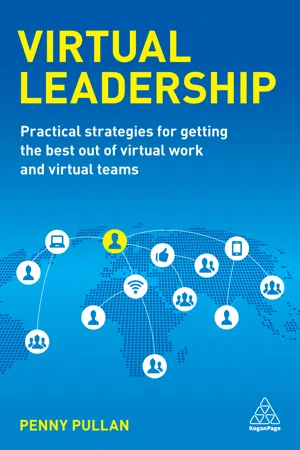![]()
05
Leading virtual meetings
This chapter explores how to lead virtual meetings. It considers live meetings where people meet at the same time, although they are dispersed geographically. To meet like this requires the support of synchronous technologies, such as audio and/or video, or even a virtual world! This chapter discusses how to prepare for virtual meetings, how to run effective meetings where people are engaged and involved in the topic, and how to make sure that actions happen afterwards. I will look at situations where you can make a positive difference even if you are not in charge of running the meeting. I discuss how to deal with meetings where some people are face to face and others are remote. As always, I will share how best to make meetings work for human beings.
Of course, virtual leadership is not only achieved through meetings, but also in between meetings. This chapter focuses on meetings and the next chapter focuses on working together outside of meetings.
By the time you have finished this chapter, you will:
- Have a clear understanding of how best to prepare for virtual meetings.
- Be able to choose strategies to engage people during your virtual meetings.
- Know how to encourage people to take action after your meetings.
- Have a range of ideas to apply when you are not in charge.
- Know how to run meetings with both face-to-face participants and remote participants.
- Be able to design your meetings for human beings.
My hope for you is that, after reading this chapter, your future virtual meetings are effective, productive and enjoyable for everyone concerned, yourself included!
Figure 5.1 Mind-map of this chapter
Why leading meetings matters
In this chapter, we explore leading virtual meetings. This means facilitating groups of people who are not together in the same room. They are likely to be diverse in several ways: from the cultures of their different countries to the different roles they play, from their mother tongues to the different generations represented.
While many people try to chair virtual meetings in a traditional way, command-and-control does not work that well remotely. People tend to mentally check out of meetings that are led in this way: they might still be on the phone line or connected to the technology but their minds will be anywhere other than the meeting. It takes a new style of facilitative leadership – inspiring people and engaging their interest – to keep them paying attention in virtual meetings.
By acting as a facilitator, the leader aims to make things as easy as possible for participants, allowing them to achieve their goals as effectively as they can. Indeed, the Latin origins of the word facilitate mean ‘to make easy’. David Sibbet describes facilitation as ‘the art of leading people through processes towards agreed-upon objectives in a manner that encourages participation, ownership and creativity from all involved’ (Sibbet, 2003). Participation, ownership and, dare I say it, creativity are all too lacking from most virtual meetings! A facilitative leadership style is the most effective way I know to run virtual meetings. Done well, participation, ownership and creativity will follow. I will explore this style of working throughout this chapter.
While facilitation is easiest when the facilitator is neutral, a virtual leader is highly unlikely to be neutral! They will have their own views as both leader and a member of the team, as well as wanting the group to be effective and come to their own decisions. This means that a leader will need to manage a couple of ‘hats’ when working with virtual groups: their ‘hat’ as the neutral facilitator of the group plus their ‘hat’ as a valuable team member, and leader.
It is best to wear one ‘hat’ at any one time, being clear at each moment whether you are playing a neutral facilitator or the team leader with valuable information to share. This complex role mixing is often known as facilitative leadership.
While much of what I present will give you good ideas as to how to manage virtual meetings, it is leadership that makes the difference between mediocre meetings and great ones, with the leader sharing the vision and modelling the way for others.
Considerations for virtual meetings
In this section, I highlight key areas that make a difference to virtual meetings. You will want to consider each of these in turn to make any forthcoming meeting a success.
Context
The first thing to check is whether a meeting is appropriate and necessary. Most virtual work is carried out between meetings using the support of collaboration tools, as we will see in the next chapter. Virtual meetings are complex, especially if you face the challenges of widely spaced time zones, a mixture of mother tongues, diverse cultures and a range of generations in the group. While meetings can be great for getting to know people and for interacting in real time, they are not necessary for every type of work. For example, many people use virtual meetings to share information on PowerPoint slides – this does not need real-time interaction and could have been done separately. Other people use virtual meetings exclusively and do not consider supplementary ways of working. So a good question is, ‘Why do you want a virtual meeting and is a meeting necessary to achieve your outcomes?’
People
Once you have chosen to hold a meeting and why, then consider the people who will participate. Why is each coming? What role will they play? What will they bring to the meeting? What resources do they need to take part (perhaps access to particular technology or a running translation)? We covered the aspects of working with others in Chapter 3 and you might find it useful to refer back there to consider your team culture, identity, levels of trust and more. What complexities will they introduce that you will need to handle? See Chapter 7 for more on dealing with culture, language, generation and wide time zones.
Hierarchy and politics
Once you have identified the participants for your virtual meeting, consider the mix. Will there be people from different levels in your organization? If so, could hierarchy interfere? Consider allowing anonymous input, where the group give ideas without identifying who has contributed each idea. You can organize this with a neutral person collecting everyone’s input and then posting these onto a shared screen. This neutral person needs to be trusted by everyone or the flow of ideas will stop. Alternatively, arrange for people to contribute their ideas ahead of time anonymously. Remember that they might feel that their contributions can be traced back if given in electronic form, which can hinder participation. Anonymous input can also be useful in cases where office politics might affect the outcomes of your meeting.
If an upcoming meeting is particularly important or contentious, then it helps if the virtual leader talks on the phone with each participant one-to-one beforehand. This can surface any concerns, particular viewpoints and sticking points as you design your meeting. While it is tempting to limit these discussions to just a few senior participants, this can sow the seeds for future problems, so it is best to speak to everyone.
Technology
Virtual meetings need the support of technology that allows people in different places to communicate at the same time. You can find out more about the technology side in Chapter 4. Here are some of the possible synchronous technologies discussed there: chat, audio, shared screens with audio and/or video, smart whiteboards with audio and/or video, co-creation tools, live video, telepresence quality video rooms and virtual worlds.
As a virtual leader, make sure that all of the participants can access the technology and to the same quality.
In the 2000s, I was involved in a programme of work across governments in West Africa, chocolate companies and non-governmental organizations. Together we were working to ensure that chocolate from West Africa was produced free from the worst forms of child labour, standards set by the International Labour Organization of the United Nations and including children working rather than going to school, using machetes or spraying pesticides.
I joined the group as programme manager to set up a pilot certification programme. Staff visited a selection of independently owned cocoa farms to check that they were not using any of the worst forms of child labour. With over 3 million such farms in West Africa, this was a large undertaking!
The virtual team met face to face for an hour or two every six months, usually in Brussels or Geneva when the participants were attending other meetings. In between, we kept in touch with conference calls and e-mails. Members of the team were based in various locations, from the west coast of the United States to Ghana, Ivory Coast and various European countries. Audio and e-mail alone were not ideal, but with participants joining meetings from remote cocoa areas, it was not practical to use video or screen sharing. Reliable broadband internet was not available from many remote areas, but mobile phones worked well and e-mail was easy to access. With each team member employed by a different organization and before the days of cloud storage, we were not able to access a shared space to work and collaborate in between meetings.
I wonder how different the project would be now, just a decade later, with much more widespread mobile broadband and access ...

